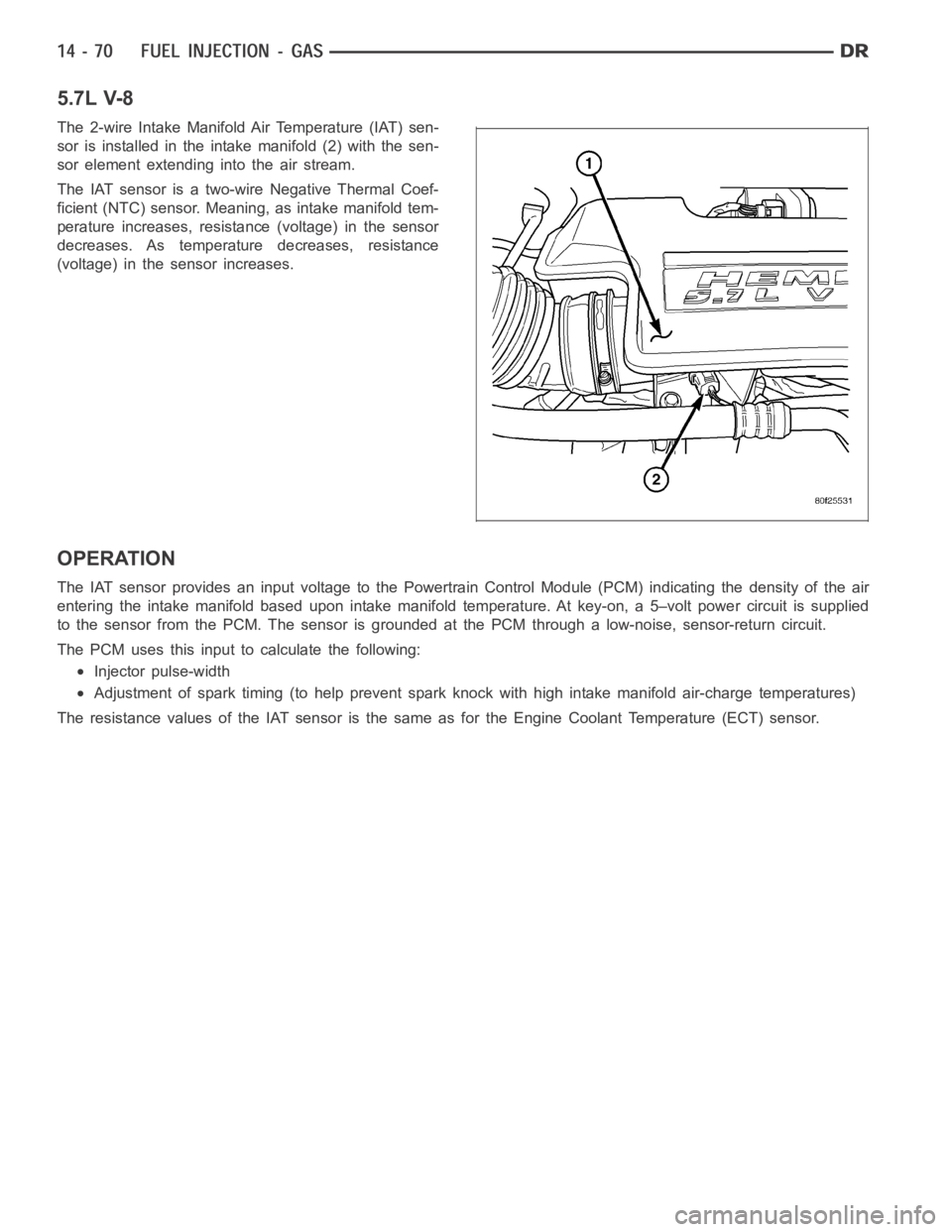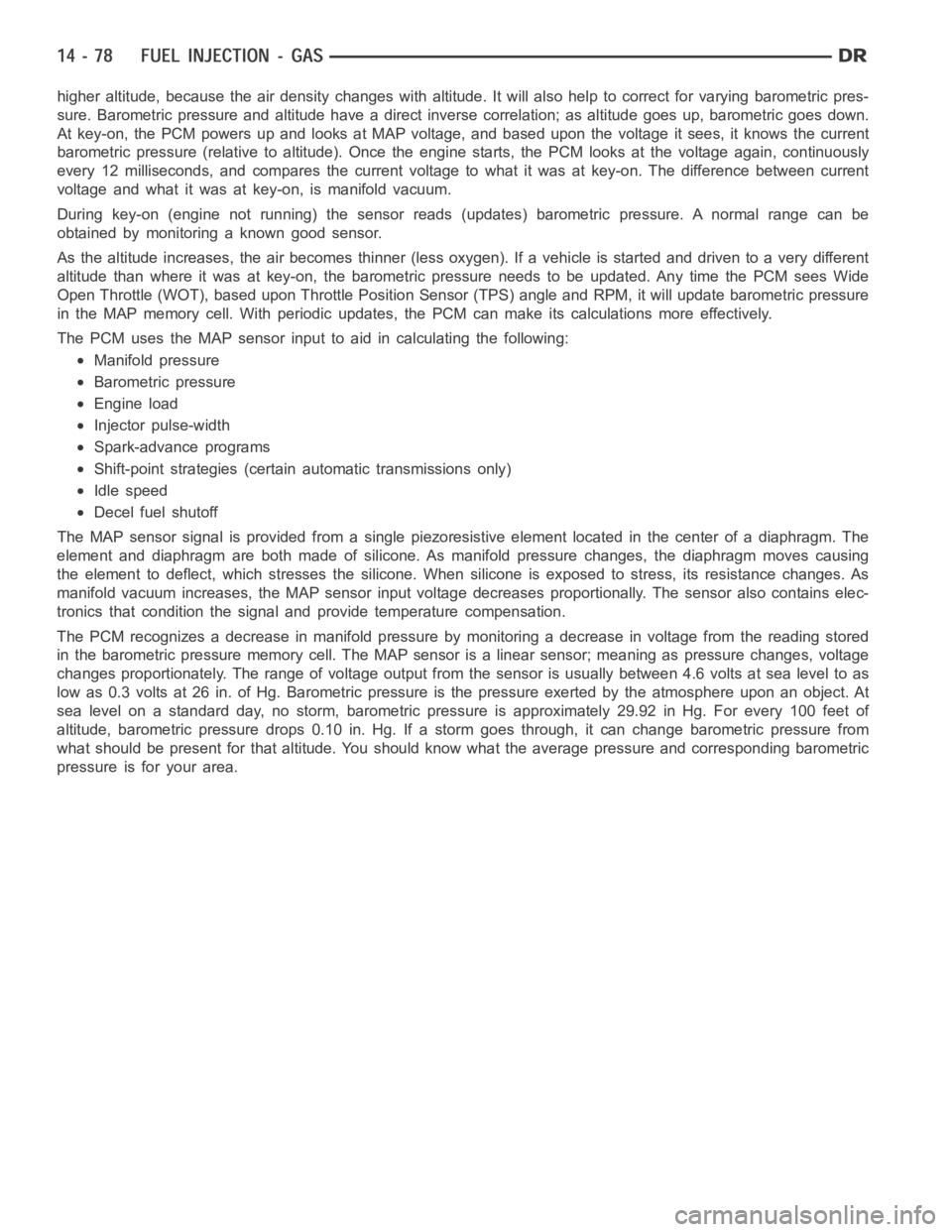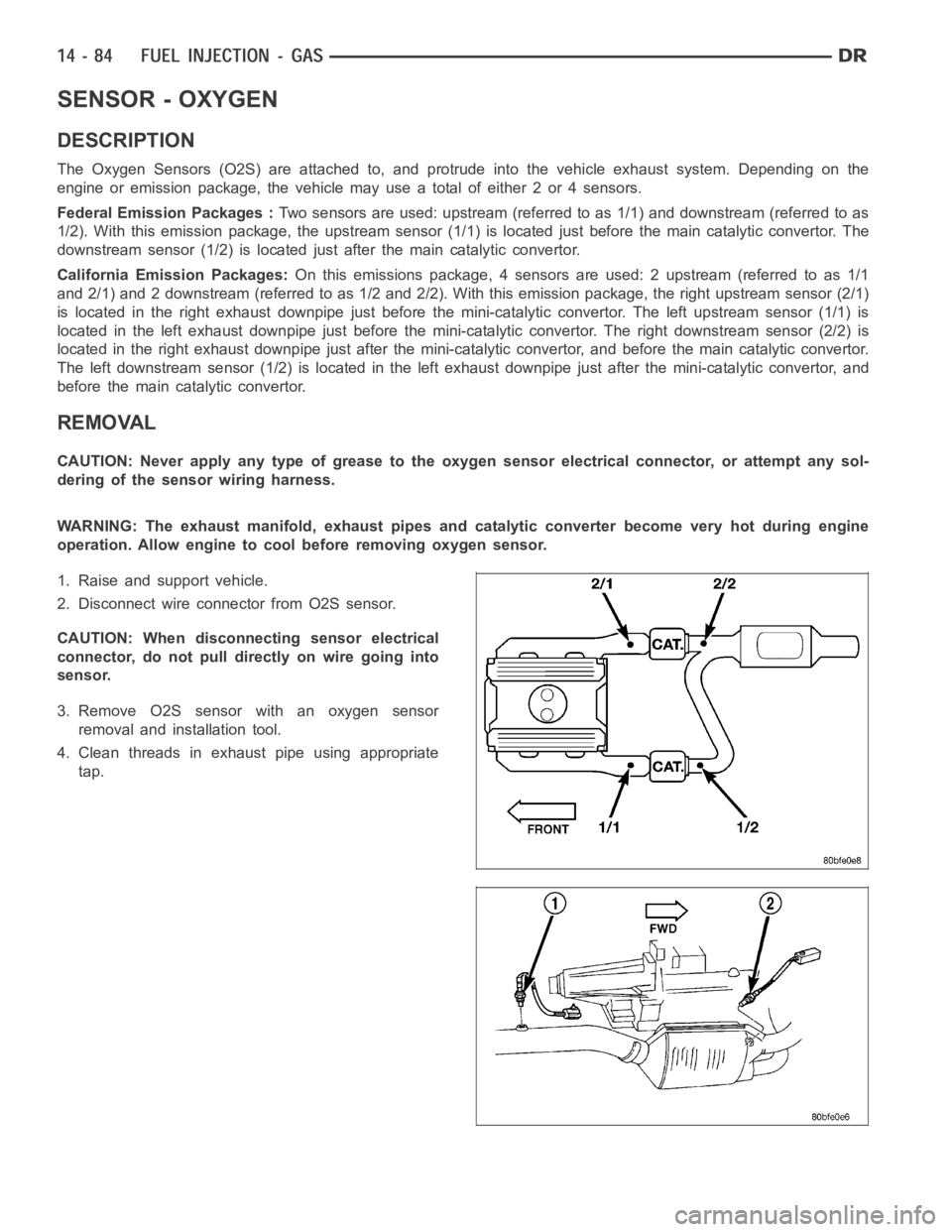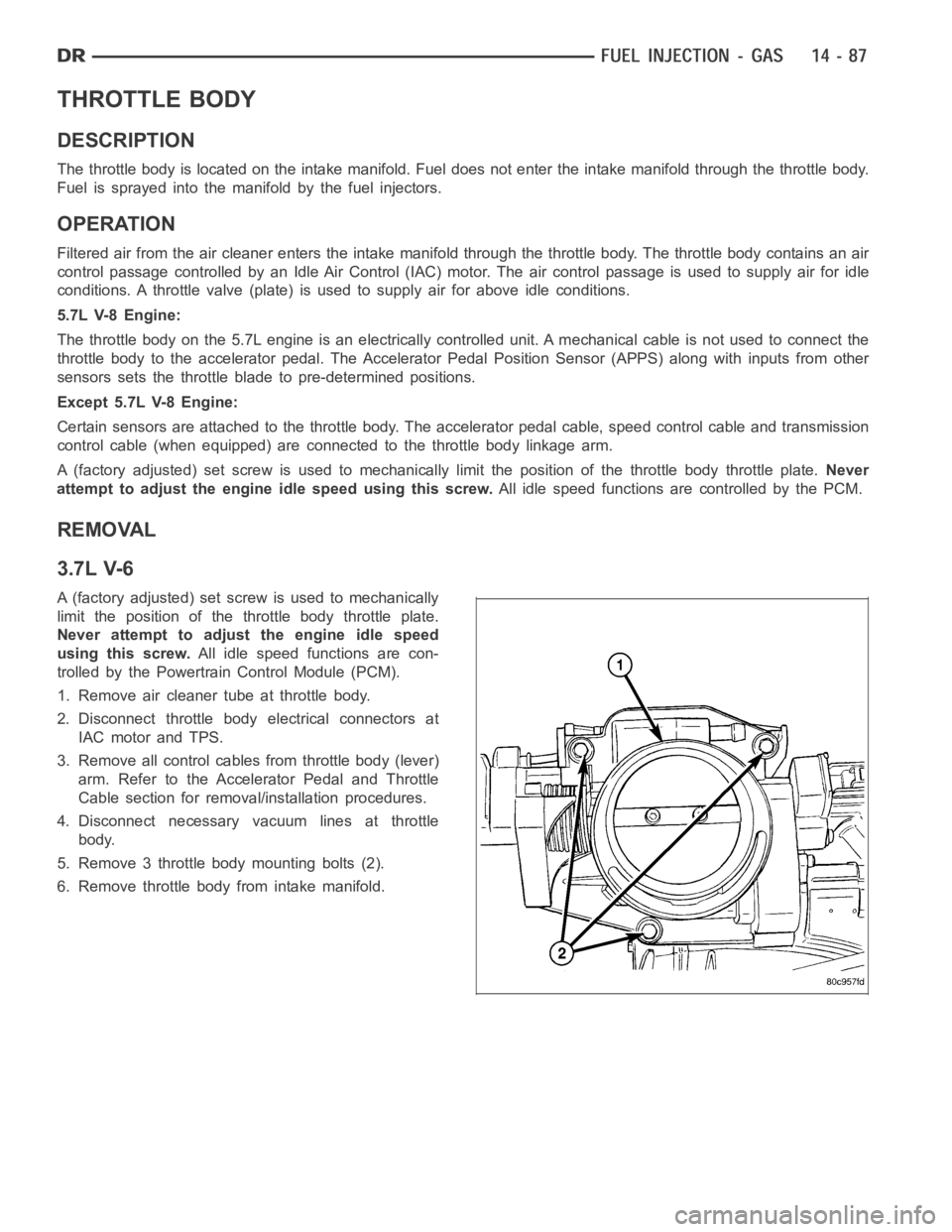Page 2303 of 5267
INSTALLATION
3.7L V-6
The Idle Air Control (IAC) motor (3) is located on the
side of the throttle body.
1. Install IAC motor to throttle body.
2. Install and tighten two mounting bolts (screws) to 7
Nꞏm (60 in. lbs.) torque.
3. Install electrical connector.
4. Install air resonator to throttle body.
4.7L V-8
The Idle Air Control (IAC) motor (3) is located on the
side of the throttle body.
1. Install IAC motor to throttle body.
2. Install and tighten two mounting bolts (screws) to 7
Nꞏm (60 in. lbs.) torque.
3. Install electrical connector.
4. Install air resonator to throttle body.
5.7L V-8
The IAC motor is not serviceable on the 5.7L V-8 engine.
Page 2307 of 5267

5.7L V-8
The 2-wire Intake Manifold Air Temperature (IAT) sen-
sor is installed in the intake manifold (2) with the sen-
sor element extending into the air stream.
The IAT sensor is a two-wire Negative Thermal Coef-
ficient (NTC) sensor. Meaning, as intake manifold tem-
perature increases, resistance (voltage) in the sensor
decreases. As temperature decreases, resistance
(voltage) in the sensor increases.
OPERATION
The IAT sensor provides an input voltage to the Powertrain Control Module (PCM) indicating the density of the air
entering the intake manifold based upon intake manifold temperature. At key-on, a 5–volt power circuit is supplied
to the sensor from the PCM. The sensor is grounded at the PCM through a low-noise, sensor-return circuit.
The PCM uses this input to calculate the following:
Injector pulse-width
Adjustment of spark timing (to help prevent spark knock with high intake manifold air-charge temperatures)
The resistance values of the IAT sensor is the same as for the Engine CoolantTemperature (ECT) sensor.
Page 2315 of 5267

higher altitude, because the air density changes with altitude. It will also help to correct for varying barometric pres-
sure. Barometric pressure and altitude have a direct inverse correlation; as altitude goes up, barometric goes down.
At key-on, the PCM powers up and looks at MAP voltage, and based upon the voltage it sees, it knows the current
barometric pressure (relative to altitude). Once the engine starts, the PCM looks at the voltage again, continuously
every 12 milliseconds, and compares the current voltage to what it was at key-on. The difference between current
voltage and what it was at key-on, is manifold vacuum.
During key-on (engine not running) the sensor reads (updates) barometricpressure. A normal range can be
obtained by monitoring a known good sensor.
As the altitude increases, the air becomes thinner (less oxygen). If a vehicleisstartedanddriventoaverydifferent
altitude than where it was at key-on, the barometric pressure needs to be updated. Any time the PCM sees Wide
Open Throttle (WOT), based upon Throttle Position Sensor (TPS) angle and RPM, it will update barometric pressure
in the MAP memory cell. With periodic updates, the PCM can make its calculations more effectively.
The PCM uses the MAP sensor input to aid in calculating the following:
Manifold pressure
Barometric pressure
Engine load
Injector pulse-width
Spark-advance programs
Shift-point strategies (certain automatic transmissions only)
Idle speed
Decel fuel shutoff
The MAP sensor signal is provided from asingle piezoresistive element located in the center of a diaphragm. The
element and diaphragm are both made ofsilicone. As manifold pressure changes, the diaphragm moves causing
the element to deflect, which stresses the silicone. When silicone is exposed to stress, its resistance changes. As
manifold vacuum increases, the MAP sensor input voltage decreases proportionally. The sensor also contains elec-
tronics that condition the signal and provide temperature compensation.
The PCM recognizes a decrease in manifold pressure by monitoring a decrease in voltage from the reading stored
in the barometric pressure memory cell. The MAP sensor is a linear sensor; meaning as pressure changes, voltage
changes proportionately. The range of voltage output from the sensor is usually between 4.6 volts at sea level to as
low as 0.3 volts at 26 in. of Hg. Barometric pressure is the pressure exertedby the atmosphere upon an object. At
sea level on a standard day, no storm, barometric pressure is approximately 29.92 in Hg. For every 100 feet of
altitude, barometric pressure drops 0.10 in. Hg. If a storm goes through, it can change barometric pressure from
what should be present for that altitude. You should know what the average pressure and corresponding barometric
pressure is for your area.
Page 2321 of 5267

SENSOR - OXYGEN
DESCRIPTION
The Oxygen Sensors (O2S) are attached to, and protrude into the vehicle exhaust system. Depending on the
engine or emission package, the vehicle may use a total of either 2 or 4 sensors.
Federal Emission Packages :Two sensors are used: upstream (referred to as 1/1) and downstream (referred to as
1/2). With this emission package, the upstream sensor (1/1) is located just before the main catalytic convertor. The
downstream sensor (1/2) is located just after the main catalytic convertor.
California Emission Packages:On this emissions package, 4 sensors are used: 2 upstream (referred to as 1/1
and 2/1) and 2 downstream (referred to as 1/2 and 2/2). With this emission package, the right upstream sensor (2/1)
is located in the right exhaust downpipe just before the mini-catalytic convertor. The left upstream sensor (1/1) is
located in the left exhaust downpipe just before the mini-catalytic convertor. The right downstream sensor (2/2) is
located in the right exhaust downpipe just after the mini-catalytic convertor, and before the main catalytic convertor.
The left downstream sensor (1/2) is located in the left exhaust downpipe just after the mini-catalytic convertor, and
before the main catalytic convertor.
REMOVAL
CAUTION: Never apply any type of grease to the oxygen sensor electrical connector, or attempt any sol-
dering of the sensor wiring harness.
WARNING: The exhaust manifold, exhaust pipes and catalytic converter become very hot during engine
operation. Allow engine to cool before removing oxygen sensor.
1. Raise and support vehicle.
2. Disconnect wire connector from O2S sensor.
CAUTION: When disconnecting sensor electrical
connector, do not pull directly on wire going into
sensor.
3. Remove O2S sensor with an oxygen sensor
removal and installation tool.
4. Clean threads in exhaust pipe using appropriate
tap.
Page 2323 of 5267
SWITCH-PTO
DESCRIPTION
This Powertrain Control Module (PCM) input is used only on models equippedwith aftermarket Power Take Off
(PTO) units.
OPERATION
The input is used only to tell the PCM (or ECM-Diesel) that the PTO has been engaged. The PCM (or ECM) will
disable (temporarily shut down) certain OBD II diagnostic trouble codes when the PTO is engaged.
JTEC and NGC Engine Controllers:When the aftermarket PTO switch has been engaged, a 12V + signal is sent
through circuit G113 to PCM pin A13. The PCM will then sense and determine that the PTO has been activated.
CM 845 or CM 848 Diesel Engine Controllers:When the aftermarket PTO switch has been engaged, a 12V +
signal is sent through circuit G113 to ECM pin B38. The ECM will then sense and determine that the PTO has been
activated.
Page 2324 of 5267

THROTTLE BODY
DESCRIPTION
The throttle body is located on the intake manifold. Fuel does not enter theintake manifold through the throttle body.
Fuel is sprayed into the manifold by the fuel injectors.
OPERATION
Filtered air from the air cleaner enters the intake manifold through the throttle body. The throttle body contains an air
control passage controlled by an Idle Air Control (IAC) motor. The air control passage is used to supply air for idle
conditions. A throttle valve (plate) is used to supply air for above idle conditions.
5.7L V-8 Engine:
The throttle body on the 5.7L engine is an electrically controlled unit. A mechanical cable is not used to connect the
throttle body to the accelerator pedal. The Accelerator Pedal Position Sensor (APPS) along with inputs from other
sensors sets the throttle blade to pre-determined positions.
Except 5.7L V-8 Engine:
Certain sensors are attached to the throttle body. The accelerator pedal cable, speed control cable and transmission
control cable (when equipped) are connected to the throttle body linkage arm.
A (factory adjusted) set screw is usedto mechanically limit the position of the throttle body throttle plate.Never
attempt to adjust the engine idle speed using this screw.All idle speed functions are controlled by the PCM.
REMOVAL
3.7L V-6
A (factory adjusted) set screw is used to mechanically
limit the position of the throttle body throttle plate.
Never attempt to adjust the engine idle speed
using this screw.All idle speed functions are con-
trolled by the Powertrain Control Module (PCM).
1. Remove air cleaner tube at throttle body.
2. Disconnect throttle body electrical connectors at
IAC motor and TPS.
3. Remove all control cables from throttle body (lever)
arm. Refer to the Accelerator Pedal and Throttle
Cable section for removal/installation procedures.
4. Disconnect necessary vacuum lines at throttle
body.
5. Remove 3 throttle body mounting bolts (2).
6. Remove throttle body from intake manifold.
Page 2326 of 5267
1. Remove air duct and air resonator box at throttle
body.
2. Disconnect electrical connector (2) at throttle body.
3. Remove 4 throttle body mounting bolts (4).
4. Remove throttle body from intake manifold.
5. Check condition of throttle body O-ring (2).
6. If the throttle body has been changed, the following
procedure must be performed:
a. Disconnect negative battery cable from battery.
Leave cable disconnected for approximately 90
seconds.
b. Reconnect cable to battery.
c. Turn ignition switch ON, but do not crank
engine.
d. Leave ignition switch ON for a minimum of 10
seconds. This will allow PCM to learn throttle
body electrical parameters.
Page 2327 of 5267
8.3L - SRT-10
1. Remove the throttle cable.
2. Remove the battery cover and disconnect the neg-
ative battery cable.
3. Remove the air cleaner assembly, refer to the
Engine/Air Intake System/Air Cleaner Housing for
more information.
4. Disconnect the TPS electrical connector.